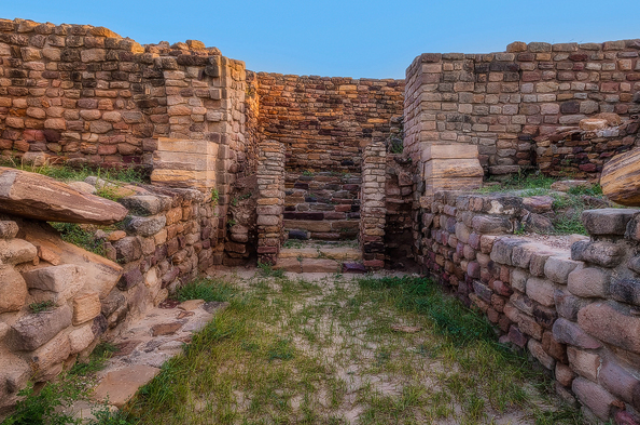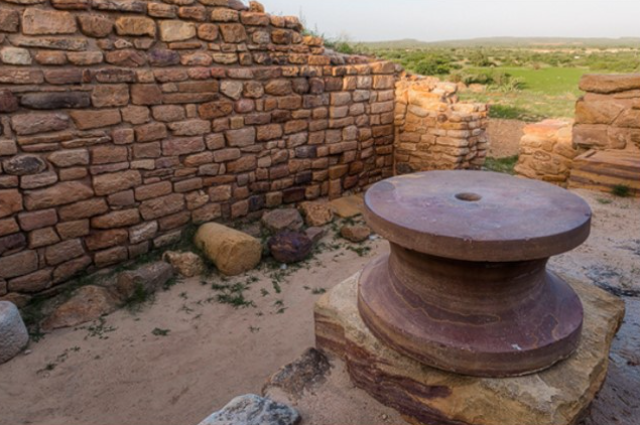
Introduction
Dholavira is one of the two largest Harappan sites in India and the fifth largest in the subcontinent. It is among the two most notable excavations of the Indus Valley Civilization, which was in existence about 4500 years ago. Another site is Lothal. The site was discovered by Jagat Pati Joshi in 1968 and excavated by R.S. Bisht, both from the Archaeological Survey of India (ASI), for 13 field seasons from 1989 to 2005. Dholavira is one of the six largest Harappan cities of the third millennium BCE, along with Mohenjo-Daro, Lakhanjo-Daro, Harappa, Ganverivala (all four in Pakistan), and Rakhigarhi (in Haryana). Dholavira witnessed a long occupation between 3000 BCE and 1500 BCE, expanding to a fully grown city in about 2600 BCE. It started to show signs of decline by 1900 BCE, like many other Harappan cities. It shrank in size, was briefly deserted, and survived for a couple of centuries. Thereafter, long desertion took place and the site was finally occupied by fully deurbanised people.1 On July 27, 2021, UNESCO inscribed this Harappan city in its World Heritage List.
The literal meaning of the name Dholavira is "Waterholes in a river with a white sand bed". Located on Khadir Island in Gujarat's Rann of Kutch, near the village of Dholavira, its ruins are locally known as "Kotada (Walled city/large fort). Dholavira is spread over 100 hectares of semi-arid land.
Discoveries from the excavation

These are the most significant discoveries from the site highlighting the culture of the Indus Valley However, they are vague. The remains existing on the site show an impressive array of other prominent features which can be enumerated as such:
1. Town planning
According to Dr. Ravindra Singh Bisht, former Joint Director-General of the Archaeological Survey of India under whose supervision the Dholavira excavations were carried, "Dholavira was the first such excellent example of town planning with mathematical precision, both arithmetic, and geometry". There the stone quarries were found that manufactured beautiful objects. Not only this but also, objects like beads found in Mohenjo-Daro and Harappa seem to have been transported from this site. Further, there are several gates, including the North Gate with a signboard above it which is the first of its kind found at the Harappan site. The board could have been made of wood and decomposed fully.2 The imposing gates of the castle displayed exquisitely polished pillar members, quarried three kilometers away. These pillar members were also transported to far-off Mohenjo-Daro and Harappa, probably through a navigable Rann of Kutch and upstream the Indus River.3 However, the gypsum letters of the inscription were found which speaks volumes about their advanced knowledge and ingenuity. The whole area was divided into a citadel, the middle town and lower town. It was designed for different categories of residents and purposes. While the castle was meant for an important person, the middle town housed rich merchants and generals and the lower town was inhabited by the common people. At the site, an annexe used as a warehouse, two grounds, bead-making workshop and Graves were also found. The larger of the two grounds equipped with seating for spectators all around resembled much like modern-day stands of the stadium. It was supposed to be used for cart-racing, animal races and races by humans too. Besides that, it was used for festivities also as is evident from a large number of beads that would have fallen down from the bodies of the wearers while dancing. Moreover, evidence of the use of the ground for trading purposes was also found. The presence of temporary structures of grass and wood on the site point towards the existence of bazaars.4
2. Memorials at the city
The inhabitants of Dholavira seemed to follow distinct funerary traditions. They were erecting mostly memorial burials using locally available stone slabs. However, in case of elite burials, they also created earthen tumuli, the largest of them reaching 30 m in diameter and rising to a height of two meters.5 According to Dr. Bisht, these memorials seem to be constructed a year after the death of a person as there were not found any skeletons, though there was evidence of offerings being made. This was akin to the shradh ceremony to mark one year of a loved one's passing away. The memorials also had designs similar to that found in Buddhist stupas.6
3. Water conservation and drainage system
Dholavira is the repository of one of the oldest excavated water conservation systems in the world. Satellite images show an underground reservoir and a skillfully constructed rainwater and harvesting system extending from the walls. The populace wouldn't have survived at Dholavira in absence of such a water conservation structure. They adopted very advanced water conservation and harvesting systems ranging from building a series of connected reservoirs, stone, and terracotta drainage pipes to wells. They also built dams on the two rivers, Mansar and Manhar flowing around the city during this time. They were able to sustain themselves when the climate changed severely resulting in a weak monsoon from the good monsoon. They survived by adopting water conservation techniques which reflected their resilience and participatory nature of the society.7 Further, it may be mentioned here that the area had a network of drains connected to an arterial drain that was underground. "All these drains are usually found containing freshwater deposits, and not sewage nor household waste, nor are these connected to house drains. It was only during Stage VI [1,950 BCE-1800 BCE] that a house drain seems to be discharged into one of the stormwater drains when those had already become defunct. The purpose of these drains was surely to let out the monsoon run-off, which is why these are found furnished with air ducts at short intervals", The nomination dossier said (for UNESCO tag).
4. Economic activities
As mentioned above, one of the two grounds within the Walled City, a highly secured Ceremonial Ground to the north of the castle and Bailey appears to be the market and a place for craft activities. Craftspeople worked stone, shell, copper, gold, silver, and lead into bangles, beads, inlay pieces, and other ornaments, ladles, weights, and metal implements, thus contributing to the city's vibrant economic life.
There is also evidence of trade contacts with West Asia which comes before us in the form of a specific type of ceramics known as 'black-slipped jar', often 1.5 m in height and with a pointed base to be fitted in a ship, agate-carnelian beads, often decorated with white patterns, and circular Indus seals, among others. Thus, Dholavira happened to be strategically located to harness Gujarat's mineral resources such as copper, limestone, steatite, agate-carnelian, several types of jasper, Amazonite, and shell from Kachchh's coast. It controlled a huge hinterland engaged in commercial activities, which encompassed important Harappan settlements viz. Bagasra, Shikarpur, Surkotada, Nagwada, Kanmer and Lothal. The city used to be a manufacturing hub, procuring and redistributing both raw and finished materials. However, at the same time, it was able to develop a sustainable subsistence regime of agro-pastoral activities.9
Decline of Dholavira
It seems that after a peak of development, culture was abandoned in Dholavira. It has been found that after this, the settlers returned with a significantly deurbanised culture. They chose on their own a simplistic lifestyle, stunning thereby their glorious past. By 1900 BCE, it had started declining like many other Harappan cities. It was deserted for a brief period, shrank in size, and survived for a couple of centuries. Afterward, it was finally reoccupied by fully deurbanised people.

Climate Change and the demise of Dholavira
According to Anindya Sarkar, Professor of Geology and Isotope Geochemistry at IIT, Kharagpur, the demise of Dholavira was connected to Climate change. He averred "We analysed high resolution oxygen isotopes in mollusc shells. These are found aplenty in Dholavira, many of them were finely cut by humans and being consumed for food. These moluscs typically grow in mangroves suggesting that the people were harvesting them from nearby mangroves. The isotopes tell about the sources and the seasonality of water in which these animals grew. Surprisingly, when we analysed the Early to Mature Harappan molluscs (2,700-year BCE old), it looked that they grew in water that is only possible if glacial meltwater mixes in the mangrove. The seasonality was high. This clearly suggested that a glacier-fed river was debouching in the Rann of Kutch. But then isotopes in the molluscs from terminal part of Mature to late Harappan from 2,300 to 2,100 years BCE indicated that the glacial contribution disappeared, and seasonality reduced. This is the time that exactly coincides with the decadence and fall of the city of Dholavira, as indicated by the archaeological evidence and the onset of the newly proposed Meghalayan stage (a division of geological time) by an international body of geologists and stratigraphers. The monsoon was anyway declining. When the Meghalayan drought came lasting a few centuries, the whole city collapsed. The collapse of Harappan Dholavira was near-synchronous to the decline at all the Harappan sites in India like Kalibangan, Lothal, Rakhigarhi as well as Mesopotamia, and the Old Kingdom of Egypt and China." Thus, the disappearance of glacial contribution, weak monsoon, and the long-time Meghalayan drought were instrumental in the gradual demise of the flourishing Harappan city of Dholavira.
Conclusion
Dholavira is the most spectacular Indus Valley site in India. During its heyday, it flourished in an unprecedented manner. It propagated, primarily, an urban culture. It displayed a high level of excellence in town planning. Trade and commerce crossed the national boundaries and spread to West Asian countries. However, it was deserted by the inhabitants due to unfavorable climatic conditions. It was later inhabited by unurbanised people but the glory of Dholavira could not be regained. Despite the ultimate demise of once-thriving civilisation, Dholavira has lessons for all in the field of urban town planning, water conservation, and drainage system and the effective use of local crafts in augmenting trade and commerce. And that is probably true about the whole Indus Valley Civilization.
. . .
References
- V.N.Prabhakar & Michel Danino, India's Earliest Smart City, The Economic Times, Jul 31, 2021.
- Damini Nath, Dholavira, Ruins of an Indus Valley civilisation, The Hindu, Aug 1, 2021.
- Supra at f.n.1.
- Supra at f.n.2.
- Supra at f.n. 1.
- Supra at f.n.2.
- Anindya Sarkar, "Dholavira is the most spectacular Indus Valley site in India; its decline was connected to Climate change", The Times of India, Feb 26, 2020.
- Supra at f.n.2.
- Supra at f.n.1.
- Supraat f.n. 2.
